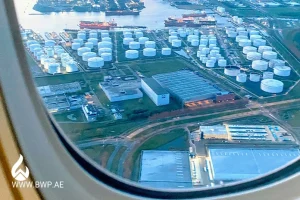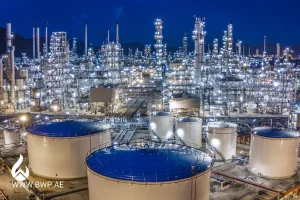Most people think that with the advent of new energy sources such as renewable energy or green energy, fossil fuels will lose their place. But the reality is different. These new methods have not yet reached sufficient development and cannot meet all human needs; therefore, fossil fuels are still used as an energy source. Therefore, proper storage of these resources is one of the important principles in the energy industry. Do you need storage facilities ? Just contact BWP
It should be noted that fossil fuels are not only used for logistics; they are also used as fuel for power plants and, after processing, as raw materials for the manufacture of lubricants and greases.
The correct way to store fossil fuels is one of the topics that has been discussed since the discovery of this blessing, and to this day, we have reached a good stage of science so that we can take the best care of the reservoirs of this fuel. Next, we plan to talk about the types of storage systems and explain the protection methods and real-time monitoring devices for these tanks.
Base Oil Group 2 Products BWP : Base Oil N150 ، Base Oil N100
What Is Crude Oil Preservation and Why It Matters
Crude oil preservation is the practice of maintaining the chemical stability, cleanliness, and physical integrity of crude oil from the moment it enters a storage facility until it is transferred for refining or sale. Crude oil, in its raw form, contains a mix of hydrocarbons, water, salts, sediments, and gases that can react or separate over time if not properly managed. Without proper preservation, crude can degrade—developing sludge, losing volatile components, or becoming corrosive—all of which reduce its market value and usability.
Preservation matters because the quality of crude directly affects refining efficiency, yield, and operational safety. For traders and storage operators, maintaining oil integrity ensures it meets buyer specifications and retains its trading value over time, which is essential in markets driven by timing and arbitrage. It also minimizes the need for costly reprocessing or blending. In addition, poorly preserved oil can damage infrastructure and pose serious environmental and regulatory risks. Therefore, crude preservation isn’t just a technical necessity—it’s a strategic priority that safeguards profitability, compliance, and reputation in the petroleum value chain.
For more information, read the article linked below:
Base Oil Supply Chain Challenges and Solutions in 2025
Challenges of Storing Untreated Crude Oil
Untreated crude oil is a chemically complex mixture, and storing it without proper handling can lead to a range of operational and economic challenges. One of the most pressing issues is the presence of water, salts, and sediments, which can settle at the bottom of tanks as Basic Sediment and Water (BS&W). Over time, this buildup promotes corrosion and can severely damage tank walls, pipelines, and valves, leading to expensive repairs and unplanned downtime.
Another critical challenge is the presence of reactive compounds like hydrogen sulfide (H₂S) and sulfur, which not only pose health and safety hazards but also contribute to the internal corrosion of storage equipment. Additionally, lighter hydrocarbons in crude oil tend to evaporate under fluctuating temperatures, increasing vapor pressure, causing product loss, and heightening the risk of volatile emissions.
Thermal instability is yet another concern—waxes in heavy crude can solidify in cold conditions, while excessive heat can accelerate degradation processes and cause changes in viscosity and density. Incompatibility between different crude grades stored in the same system can also result in emulsion formation and chemical imbalance. All of these factors make untreated crude oil difficult to manage and underline the need for advanced preservation techniques and purpose-built storage infrastructure.
Materials and Coatings Used in Modern Storage Tanks
Modern crude oil storage tanks are engineered with specialized materials and protective coatings to withstand the harsh chemical nature of crude and the environmental conditions in which they operate. Carbon steel remains the most widely used construction material due to its strength, cost-efficiency, and compatibility with a range of crude types. For more corrosive environments or highly reactive crude grades, stainless steel or aluminum alloys may be used to improve resistance and longevity.
However, the real line of defense lies in the internal coatings. Epoxy-based coatings are commonly applied to the interior surfaces of tanks to prevent corrosion from water, salts, and acidic compounds present in untreated crude. Advanced lining systems, such as glass-flake reinforced epoxy or polyurethane coatings, offer added chemical resistance and thermal stability—ideal for regions with extreme temperatures.
External coatings also play a crucial role in environmental protection, reducing heat absorption and shielding the tank from UV radiation, moisture, and atmospheric pollutants. Proper material selection and coating application not only extend the life of storage assets but also reduce maintenance costs, improve safety, and help ensure the crude oil remains uncontaminated and market-ready throughout its storage cycle.
Temperature and Pressure Control in Oil Storage
Temperature and pressure regulation are critical factors in maintaining crude oil stability during storage. Without proper control, fluctuations in ambient temperature can trigger chemical reactions, cause phase separation, or lead to the solidification of waxes—especially in heavier crude blends. In colder climates, paraffinic crudes may thicken or form wax deposits, obstructing flow and complicating pumping operations. To counter this, many storage tanks are equipped with built-in heating coils or external heating systems to maintain a stable oil temperature.
In hot environments, excessive heat increases vapor pressure, accelerating the evaporation of light hydrocarbons. This not only reduces the volume and value of stored oil but also heightens the risk of VOC emissions and pressure buildup. To manage this, tanks are fitted with pressure-relief valves, flame arrestors, and venting systems that maintain safe internal conditions.
Thermal insulation is often applied to reduce temperature variation and energy consumption in both heating and cooling systems. In floating roof tanks, temperature control works in tandem with vapor control to minimize losses. By maintaining optimal thermal and pressure conditions, storage operators protect crude quality, ensure equipment longevity, and uphold safety standards—key elements in efficient and responsible crude oil storage operations.
For more information, read the article linked below:
Oil storage for rent
Preventing Contamination and Degradation
Preserving the purity and stability of stored crude oil requires proactive measures to prevent contamination and degradation. One of the most common threats is water ingress—whether from rainwater, condensation, or pipeline transfer—which can lead to microbial growth, emulsion formation, and increased BS&W levels. If left unchecked, these issues can degrade the oil’s commercial quality and damage downstream equipment.
To mitigate contamination, modern storage tanks are designed with floating roofs that minimize air contact and reduce condensation. Nitrogen blanketing is also employed in fixed-roof tanks to create an inert atmosphere that prevents oxidation and suppresses vapor formation. In addition, segregating crude by type and API gravity is a standard practice to avoid chemical incompatibility that could cause asphaltene precipitation or emulsion instability.
Filtration and dehydration systems are often integrated into the storage process to remove suspended solids and separate free water from crude before or during storage. Periodic draining of tank bottoms helps eliminate settled sludge and contaminants, preserving internal tank conditions and crude integrity. Ultimately, rigorous contamination control not only ensures the stored crude remains within spec but also extends asset life and reduces the risk of costly reprocessing or regulatory non-compliance.
Monitoring and Automation in Storage Facilities
Modern crude oil storage facilities are increasingly reliant on advanced monitoring and automation systems to ensure operational efficiency, safety, and product integrity. Real-time data acquisition is key—sensors embedded within tanks continuously monitor parameters such as oil level, temperature, pressure, and vapor composition. These readings are transmitted to centralized control systems, typically integrated through SCADA (Supervisory Control and Data Acquisition) or Distributed Control Systems (DCS), allowing operators to make informed decisions without manual intervention.
Automation not only enhances precision but also reduces human error and response times in critical situations. Leak detection systems, overfill alarms, and emergency shut-off mechanisms are often automated to activate instantly upon detecting abnormal conditions. Digital flow meters and batch tracking software help maintain accurate inventory control and traceability.
Advanced facilities also employ predictive maintenance tools using AI and machine learning to analyze trends in equipment behavior, flagging potential failures before they occur. In some cases, digital twins—a virtual replica of the facility—are used to simulate operations, optimize storage strategies, and plan maintenance.
By leveraging automation and intelligent monitoring, storage operators can uphold the highest standards of safety, minimize losses, and ensure consistent crude quality, all while maximizing throughput and reducing
Best Practices for Long-Term Crude Oil Storage
For long-term crude oil storage, maintaining quality and operational efficiency requires a few key practices: segregating different crude grades, ensuring regular tank rotations, and conducting frequent sampling to monitor for degradation. Routine tank cleaning and inspections are critical to prevent corrosion and sludge buildup. Scheduled maintenance for storage infrastructure, along with the use of predictive maintenance tools, helps avoid unplanned downtime. Proper documentation ensures compliance with safety and environmental standards, supporting both operational success and regulatory adherence.
For more information, read the article linked below:
Differences between group 1 and group 3 base oils
Conclusion
Crude oil preservation is crucial for maintaining its quality, ensuring market value, and mitigating risks in storage operations. By implementing advanced storage technologies, effective monitoring systems, and following best practices for maintenance, companies can enhance efficiency and reduce costs. Environmental compliance and consistent care in long-term storage ultimately safeguard assets, promote sustainability, and support profitability in a competitive and evolving energy market.Do you need storage facilities ? Just contact BWP





No comment